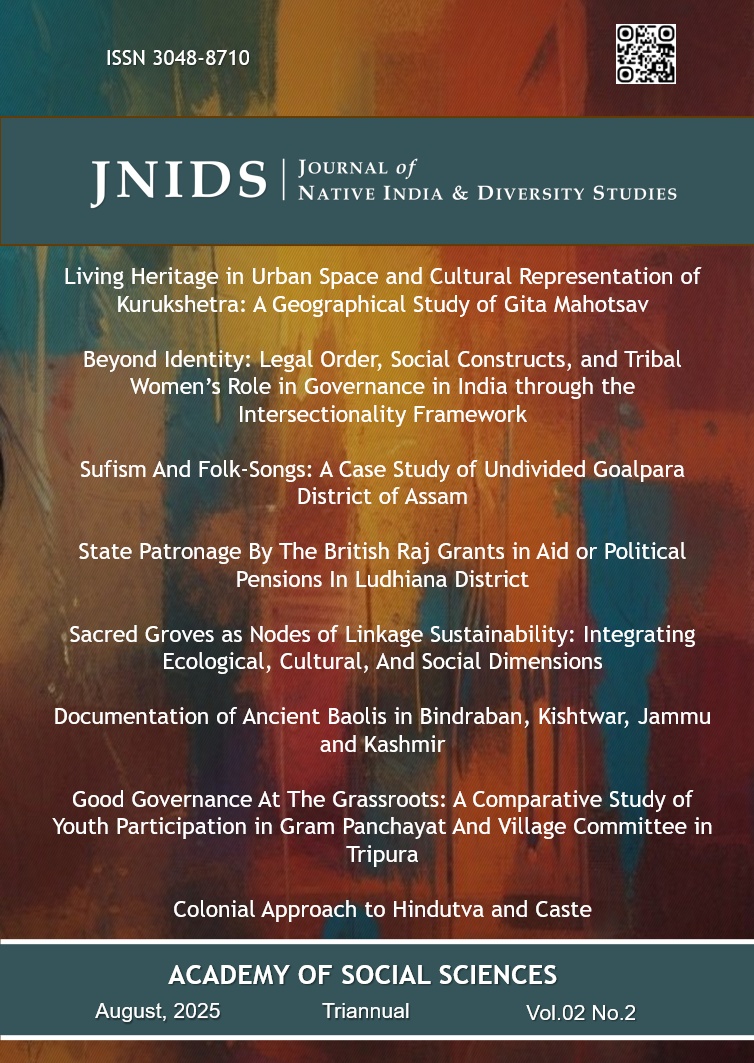Sufism And Folk-songs: A Case Study of Undivided Goalpara District of Assam
DOI:
https://doi.org/10.62656/Keywords:
Assam, Folk-Songs, Influence, Sufism, Undivided GoalparaAbstract
The convergence of Sufism and folk-songs in different places provides a captivating insight into the social, religious, and creative dynamics of a community. The undivided Goalpara district of Assam, which is renowned for its abundant cultural legacy, presents an appealing study in this context. Sufism likely interacted with the indigenous folk traditions in the undivided Goalpara area, both exerting and receiving reciprocal influence. The incorporation of Sufi-inspired lyrics into traditional folk melodies may have resulted in the creation of musical compositions that deeply connected with the native people’s spiritual and cultural sensibilities. These songs would have been a way for the community to come together and express their spirituality, in addition to being a source of amusement. The examination of the correlation between Sufism and folk songs in the original Goalpara region can yield significant scholarly perspectives on the intricacies of cultural exchange and assimilation. In addition, such a study can aid in the preservation and promotion of these rich cultural traditions, ensuring their continued viability in the face of industrialization and globalization.
References
1. Ahmed, Sohrab (ed.), (2022). Char-Chaparir Jivan Charyya (in Assamese), Natun Sahitya Parishad, Guwahati, pp. 149–151.
2. Ahmed, Wakil, (2009). Bangla Lokasangeet: Bhatiyali Gaan (in Bengali), Lekhak Samabay, Dhaka, p. 22.
3. Ahmed, Wakil, (1965). Banglar Loka-Sanskriti (in Bengali), Bangla Academy, Dhaka, pp. 291 & 294.
4. Alom, Shamsul, Age- 103, Village- Simlabari, Dist.- Goalpara (Assam), Date of Interview: 23/10/2023 (Monday).
5. Baruah, Rofiul Hussain, (1989). Islamiya Aytijya Aru Asom, Part- I (upto 1615 A.D.) (in Assamese), Lucy Publication, Jorhat, pp. 73–75.
6. Bhakat, Dwijendra Nath & Neogi, Pratima (ed.), (2015). Bhawaiya Gan (in Assamese), Banamali Prakashan, Dhubri, pp. 27–32, 458.
7. Bhattacharya, Ashutosh, (1977). Bongiyo Loka-Sangit Ratnakar (An Encyclopaedia of Bengali Folk-Song), Vo. IV, A Mukherjee and Company Pvt. Ltd., Calcutta, pp. 1681 & 1585.
8. Begum, Tania, (2020). “Vernacularisation of Islam and Sufism in Medieval Assam: A Study of the Production of Sufi Literature in Local Languages,” in International Journal of Research and Innovation in Social Science (IJRISS), Vol. IV, Issue IX, September, p. 202, retrieved from www.rsisinternational.org, accessed on 03/03/2022.
9. Dasgupta, Atis, (1994). “The Bauls and Their Heretic Tradition,” in Social Scientist, Vol. 22, Nos. 5/6, May-June, p. 72, retrieved from https://www.jstor.org/stable/3518022, accessed on 05/03/2022.
10. Hai, Muhammad Abdul, “Folk Songs of East Bengal,” in Shamsuzzaman Khan (ed.), (2014). Folklore of Bangladesh, Vol. 1, Bangla Academy, Dhaka, p. 301.
11. Hossain, Ismail, (2012). Asomor Char-Chaporir Loka-Sahitya (The Folk-Literature of Riverine Land of Assam), Banalata Prakasan, Guwahati, pp. 36 & 42.
12. Uddin, Jasim, (2012). Murshida Gan (in Bengali), Palas Publisher, Kolkata, pp. 220–221.

